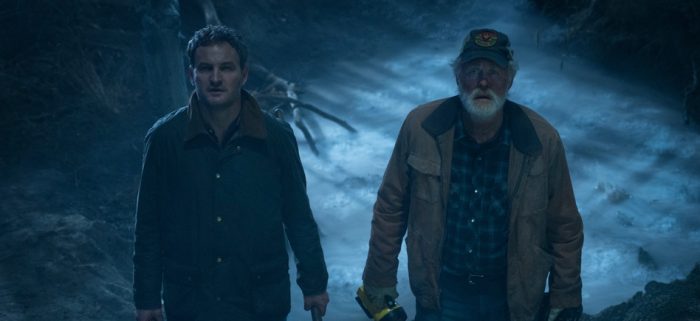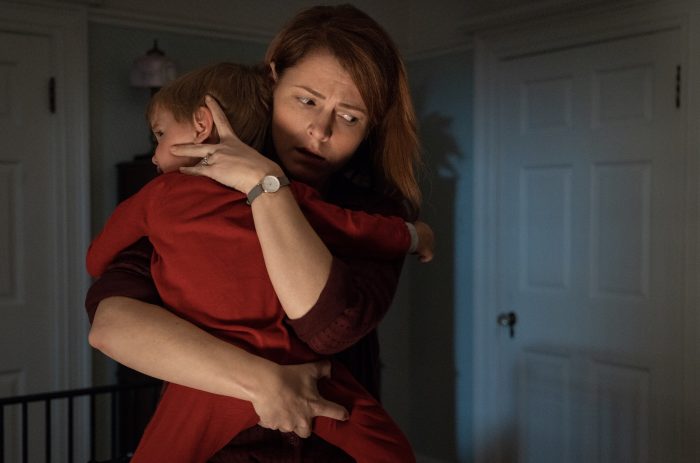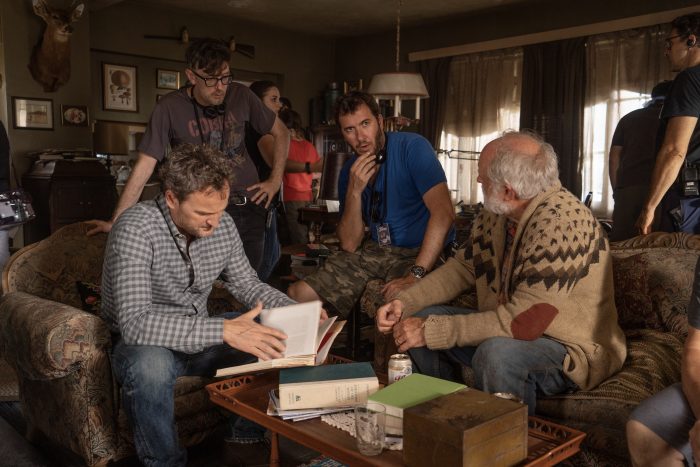‘Pet Sematary’: Bringing Stephen King’s Most Terrifying Novel to Life [Set Visit Report]
Over the summer, I had the chance to head to the Ontario set of Pet Sematary, the new adaptation/remake of Stephen King‘s 1983 novel. What I saw there excited me beyond my wildest dreams. I’m a huge Stephen King fan, and Pet Sematary is my favorite King novel, immediately making me suspicious of any adaptation. What I came away with is the knowledge and confidence that the film is in excellent hands, and might just be the next great Stephen King movie adaptation.
(This Pet Sematary set visit report is as spoiler-free as possible. Check back with us closer to the film’s release for a more spoiler-centric report.)
Sometimes, Dead Isn’t Better
We are in Ludlow, Maine. Before us stands a colonial-style house – a house that has seen better days. Its once fresh coat of white paint has chipped and peeled, like dead, dry skin flaking away from a husked corpse.
The house is flanked by trees, woodlands as far as the eye can see, and, within all that greenery, insects whirr and chirp and cry. It’s not quite dusk, but the darkness is on the horizon – waiting, watching. And so are we. We stand among dozens, maybe hundreds, of people who are frozen statue-still on the lawn, gazing up at the house. Everyone is dead silent. The only sound here is that of the insects. The air is thick and humid; discomfort has made itself at home here today.
Suddenly, from somewhere buried within the peeling house, a scream echoes – a shriek from deep within the bowels of one’s soul – harrowing and chilling and nerve-wracking. You can feel your blood run cold as the hair bristles on the back of your neck.
And then a man casually strolls by carrying several tubes of fake blood. The spell is broken. Everyone begins to move and chat amiably.
This isn’t the fictional Ludlow, Maine, after all, but somewhere in Ontario. And these figures on the lawn are the mostly French-Canadian-speaking crew of Pet Sematary, Paramount’s new adaptation of Stephen King’s terrifying novel.
Pet Sematary may not be King’s most popular work, but it is the scariest. Just ask King himself – Pet Sematary is the one novel in the author’s bibliography that actually scared him when he finished writing it. So much so that he tucked it away in a drawer, believing he’d gone too far and that it should never be published. Eventually it was published, of course, and became yet another best seller in a long line of best sellers.
It also became a movie, in 1989, directed by Mary Lambert with a script by King himself. Rumblings of a possible remake/new adaptation of King’s tome of terror attempted to crawl their way out of the grave for years. Even Guillermo del Toro showed interest. But nothing materialized. Cut to 2017: the new adaptation of King’s It broke box office records, and Hollywood finally wised up to the fact that Stephen King adaptations were big business again.
Now, Kevin Kölsch and Dennis Widmyer, the duo behind the indie horror flick Starry Eyes, are hard at work bringing a new take on King’s story to the screen. With producers Lorenzo di Bonaventura and Mark Vahradian, they’ve assembled a killer cast.
Jason Clarke (Dawn of the Planet of the Apes) is Dr. Louis Creed, who uproots his family – wife Rachel (Amy Seimetz, Upstream Color), daughter Ellie (Jeté Laurence), toddler Gage (twins Hugo Lavoie and Lucas Lavoie), and family cat Church (played by several talented felines) – to Ludlow, Maine. It should be a fresh start in an idyllic rural setting. Instead, Louis’ new neighbor, Jud Crandall (John Lithgow), introduces him to a pet cemetery – crudely spelled as pet sematary by local children – nestled deep in the woods behind Louis’ house. But that’s not the only burial ground hidden in that forest. There’s another patch of ground – the Micmac burial ground – located even further in…and it has its own dark secrets.
We’ve been brought by van to the Pet Sematary set, tucked away on a rural road about an hour outside of Ontario proper. The road looks like any other stretch of country road, and could easily double as Maine. Houses sprout up here and there like weeds, and the residents are blissfully unaware that a few miles away from their front door, untold horrors are being constructed piece by piece.
My number one goal is to catch a glimpse of the sematary itself, and I feel a bit like a child waiting for Christmas morning, anxious for that moment to come. I’m promised – or reassured might be the more accurate word – that I and the other journalists on the set visit will be brought to the sematary in good time. First, though, we drive past a huge tanker truck pulled off to one side, the word ORINCO painted carefully on the side. I catch my breath – anyone familiar with King’s novel, as I obsessively am, will recognize that as the name of the trucking company that figures significantly in the story. Seeing this here makes Pet Sematary a reality. It’s really happening. Stephen King’s scariest book is coming back from the dead.
You Bring The Horror In With You
While the crew bustles about setting up a complicated scene involving Jason Clarke and John Lithgow, directors Kevin Kölsch and Dennis Widmyer emerge from that peeling, run-down house and meet us in the yard. Both men look a bit exhausted, and yet come alive when speaking about the film. Widmyer is the more talkative of the two by far, rattling off info about the production while a cigarette burns in his hand. Kölsch sits by his side with a thoughtful look on his face, waiting to interject.
“We’re lucky that It did as well as it did, because now we’re in another Stephen King renaissance and we shouldn’t blow it,” Widmyer says. “We should be making great movies out of this material, because the material warrants it. [Pet Sematary] is a very seminal book, it’s very different from [King’s] other books. [And] our approach to the material is very mature, very grounded, and we really understood the material.”
And what of that material? How true is this Pet Sematary hewing to King’s novel, as opposed to the 1989 film adaptation?
“There were a lot of things in the book that we were always big fans of or things that didn’t even make it into the original movie that we wanted to do,” Kölsch says. “And we worked hard to get those into the script. That has been our approach, to be faithful to the book. But the best remakes are the things that stay faithful to the essence, not necessarily every single thing that happens. We’re making some changes, or doing some decisions based on the kind of things that we think would be really cool, but it’s all within the essence and the spirit of the original source material.”
This is incredibly promising to hear. Based on the footage we see being shot today, it’s clear that this Pet Sematary has nailed down the ever-present dread of King’s novel. It’s also found clever ways to remain faithful to King’s prose while also interjecting new, exciting bits, resulting in something that seems fresh and alive. Earlier in the day, on a conference call with with Lorenzo di Bonaventura, the Pet Sematary producer elaborates a bit on some of the material changes in this new adaptation.
“I would say this: we are extremely faithful to it, both in literal content and especially, in addition, in emotional,” di Bonaventura says, adding: “From the beginning we’ve tried to make the book very much our guiding light, both in literal content and in emotional content.”
But some changes were made, of course. “The one thing that I always struggled with in the book and in the movie that was made was Jud’s reasoning behind telling Louis about the burial ground, or taking him to the burial ground,” di Bonaventura says on the call.
In King’s novel, and the ‘89 film, the sudden death of the family cat inspires Jud to take Louis into the woods – to the pet sematary, and beyond. “It was an interesting process to go through the development of it because we kept trying to find a rational reason – this is why Jud would do it,” di Bonaventura continues. “But what we ended up on, which I think is an incredibly satisfying result – which is an evolution, I’ll say from the book – is that Jud is this lonely man who suddenly has a family that moves in who touches his heart. So it’s an emotional decision he makes, not a rational decision.”
This is certainly a clever approach to Jud’s motivation, and this sort of attention to detail has me excited. As does the fact that Kölsch and Widmyer understand that there’s more to Stephen King that just horror. What makes King’s work so immortal and universal is the way he creates his characters, making them seem fully formed. And the way he’s able to tap into realistic themes and graft them onto a fantastical scenario.
“The supernatural element is a tool to tell [the] story,” Widmyer tells us on set. “The same way The Shining is really about addiction because Stephen King was going through addiction at that time, and his use of the father and writer’s block and claustrophobia and stuff. It’s not about an evil hotel, you know? You bring the horror in with you, and that’s really what this story is too. So we love that stuff.”
Widmyer adds later: “This is literary horror. This isn’t just concept and shlock. This could be something more. I think we’re excited to try to tell…an elevated, really smart, mature version.”
Continue Reading Pet Sematary >>
The post ‘Pet Sematary’: Bringing Stephen King’s Most Terrifying Novel to Life [Set Visit Report] appeared first on /Film.
from /Film https://ift.tt/2pN3N7i



No comments: